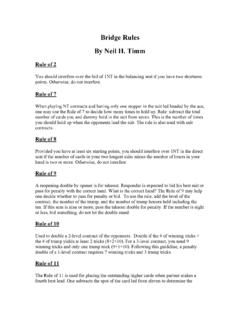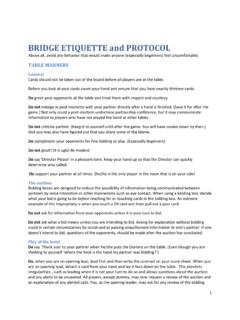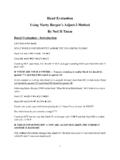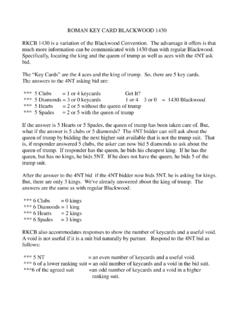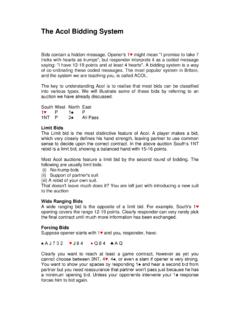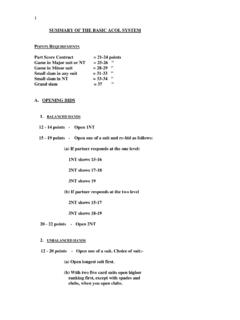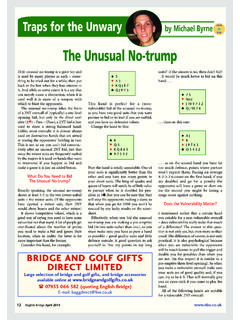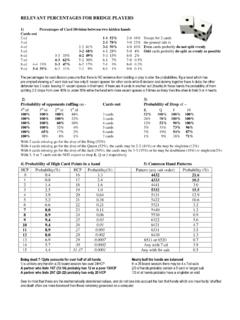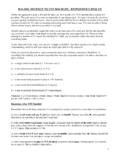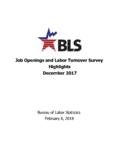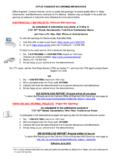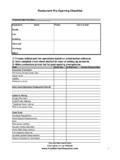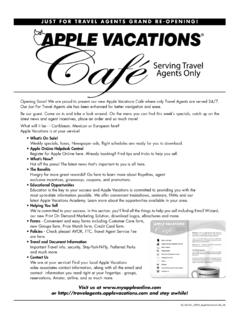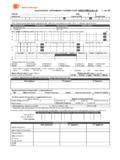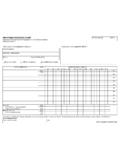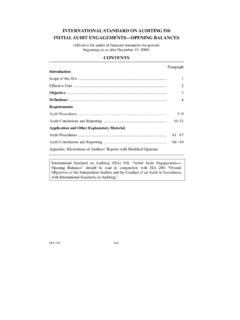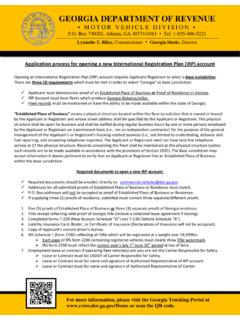Transcription of STANDARD OPENING LEADS (WHICH CARD) - …
1 1 STANDARD OPENING LEADS ( which card ) There are two main aspects to deciding the OPENING lead; which suit to lead, and which card in that suit. Here we shall only consider which card to lead in a specific suit, (although some references are made to the desirability of leading a suit with specific cards). We shall not consider which suit to lead this is a separate topic in its own right. We shall consider so called STANDARD LEADS which provide sound basic principles on which to base your defence. With experience, some pairs adopt alternative non- STANDARD (but defined) Also, whilst the discussion focuses on the OPENING lead, in principle the same general conditions apply to any new suit lead throughout the contract (although this can be tempered with the sight of dummy and developments during the play).
2 The OPENING lead is very important that one card can convey so much information to partner, it sets the tone for the whole contract. Look at the normal traveller it specifically has a column for the lead. This one card can often explain the triumphs or disasters associated with the contract. The LEADS against suit contracts and no-trumps are fundamentally different. Against a suit contract it s usually the first two rounds of a suit that are important, and consequently it s often correct to concentrate on the quick trick taking potential of a suit honours. Subsequent rounds are less important, since there is a high probability that they are going to be ruffed in any case. However against no-trumps you are trying to establish a suit; and part of this process is maintaining communications with partner, so it s much more of a patient waiting game less emphasis on the actual lead of an honour, more about trying to eventually benefit from the length of the suit.
3 STANDARD LEADS come with no guarantee that they are the right lead. However when you ve defended against hundreds of hands, they offer the best percentage of success. (Unless otherwise stated, the 10 should not be considered as an honour, unless used in an internal sequence ). Lead Against SUIT Contracts 1. From any honour sequence always lead the top honour. From an interior honour sequence lead the top of the internal honour sequence - this does include the 10 ) KQxxx QJxx AKxx J10xx KJ104 Q1097 (but not 109xx we are not considering the 10 to be an honour) (an exception is against a slam: with AK lead K expecting partner to give you count . You then know whether to continue the suit or switch).
4 2 2. From any four or more card honour suit lead 4th. highest, and from any three- card honour suit lead lowest (rare this really only occurs when leading partner s suit or an un-bid suit). AJ54 Q863 K102 97 As West, you lead the 3, and declarer plays the 4 from dummy. Knowing that you lead small from an honour, your partner, East, can safely play the 10 (the K would be a wasted card ). (As a personal hate, I try to avoid leading small from a Jack. I usually try to find another suit). 3. But one golden rule of bridge on the OPENING lead never under-lead an ace against a suit contract. If you do under-lead an ace, this may enable declarer or dummy to make a singleton king.
5 Also following this rule enables partner to make the correct play in the following situation: Q74 J9652 K103 A8 Against a suit contract West LEADS 5 (a low card implying that he has an honour). Dummy plays 4. Knowing that your partner would not under-lead the A, you must play 10. If instead you played the K, you present declarer with two spade tricks instead of one. 4. Also try to avoid leading the ace without the king try to find another suit (possible exceptions are when the opponents are in a suit slam; opponents are in 5minor having investigated 3NT and have decided against it; a singleton non-trump ace, hoping for a ruff. But even these exceptions can have their pitfalls).
6 5. 2nd. Highest From A Non-Honour Suit. From a suit without an honour ( suits headed by the 10 or less), lead the second highest. This should subsequently be followed by the highest card as long as it can be afforded. (With three cards, this is sometimes known as mud middle, up, down). AJ54 8763 K102 Q9 As West, you lead the 7, (second highest from a suit without an honour). Your partner, East, can interpret that this is not fourth highest, and must therefore play the K (the 10 may cost a trick particularly in a side suit declarer makes two tricks and can then ruff the suit). On the next play of the suit you would clarify the situation by then playing the 8 (this then shows that the 7 was not the top of a doubleton).
7 If your partner does make this lead, there is much less tendency for you to later return the suit he doesn t have an honour. For this reason this particular lead is often termed a defensive lead. 3 6. Top Of A Doubleton Usually you play the top of a doubleton (either honour or non-honour card ), obviously followed by the lower card . Partner can then judge whether to give you a ruff against a suit contract. Avoid leading Kx, or Qx (unless this is partner s suit), but if you have to, do lead the honour. An exception is where both cards in the doubleton are touching honours eg. AK, or QJ. It is STANDARD practise to lead the lower card , followed by the higher one. This distinguishes this lead from a touching honour lead (see (1) above).
8 LEADS Against NO-TRUMP Contracts (we shall consider the 10 as an honour in a sequence). 7. From any three card honour sequence always lead the highest card , KQJ64; QJ1062; J10942. 8. From a sequence of two honours with one card exactly two below the lowest honour, lead the highest card , (sometimes referred to as a 2 honour sequence) KQ1043 - the 10 is two below the Q; QJ97 - the 9 is two below the J; J1087 - the 8 is two below the 10. The idea of this is that you are hoping to trap an honour in declarer s hidden hand. A5 KQ1062 843 J97 Here you must lead the K. The diamond is taken and if partner gets the lead he can come through declarer s J.
9 If you had led small (fourth highest), declarer would make both the A and J. - see also point (12) unblocking play. 9. LEADS From Interior Sequences When you hold three honours with the lower two touching (including the 10 ), you should lead the higher of the touching cards the top of the interior sequence. eg. KJ1052; AQJ54 (arguments often arise with a suit Q109xx. I personally prefer the 10 partner now knows that it is either this situation (top of an internal sequence), or a doubleton). Q64 KJ1073 A82 95 When you (West) lead the J , if declarer plays the Q from dummy, partner covers and can return the suit with no loss for the defence; if declarer ducks, the defence still make all the tricks.
10 If however you had led the fourth highest (7 ), dummy plays low and partner s ace is wasted declarer makes one trick in the suit. This approach is useful in defining the 10 lead it is either from an interior sequence or from a doubleton. 10 . From any other honour sequence or from a single honour, lead 4th. highest, eg. ; ; AK108.; K7542; Q8753. 4 Unlike the lead against a suit contract, it is now perfectly acceptable to under-lead an ace. Another reason not to lead the top honour in this situation against no-trumps is that you may block the suit. 964 KQ732 A8 J105 If you lead the K the suit will be blocked (assuming you have no other side suit entry). Partner can t overtake with the A this will give a trick away.
